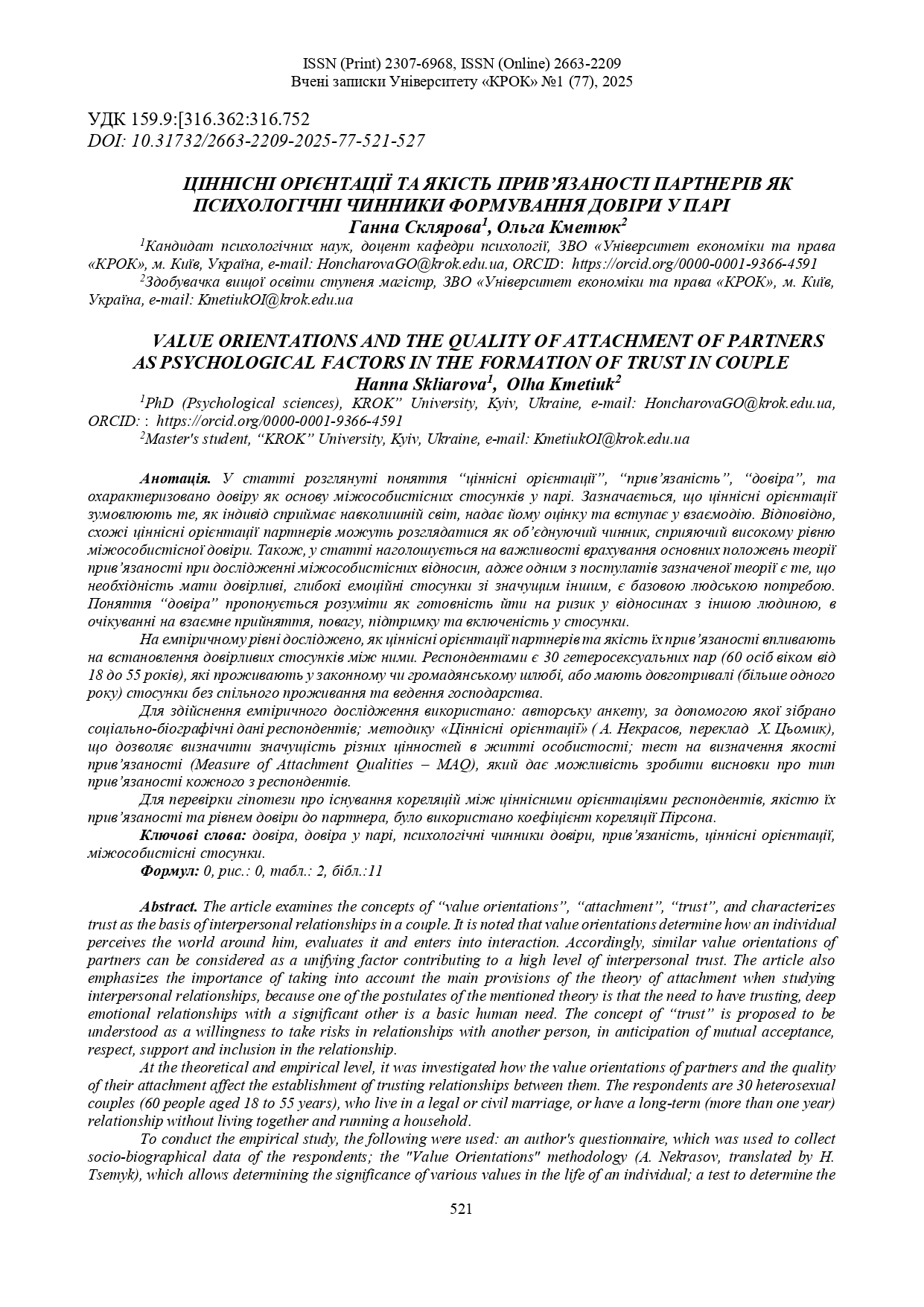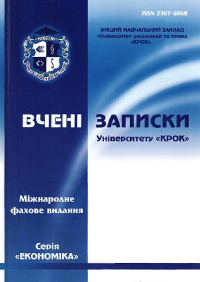VALUE ORIENTATIONS AND THE QUALITY OF ATTACHMENT OF PARTNERS AS PSYCHOLOGICAL FACTORS IN THE FORMATION OF TRUST IN COUPLE
DOI:
https://doi.org/10.31732/2663-2209-2025-77-521-527Keywords:
trust, trust in a couple, psychological factors of trust, attachment, value orientations, interpersonal relationshipAbstract
The article examines the concepts of “value orientations”, “attachment”, “trust”, and characterizes trust as the basis of interpersonal relationships in a couple. It is noted that value orientations determine how an individual perceives the world around him, evaluates it and enters into interaction. Accordingly, similar value orientations of partners can be considered as a unifying factor contributing to a high level of interpersonal trust. The article also
emphasizes the importance of taking into account the main provisions of the theory of attachment when studying interpersonal relationships, because one of the postulates of the mentioned theory is that the need to have trusting, deep emotional relationships with a significant other is a basic human need. The concept of “trust” is proposed to be understood as a willingness to take risks in relationships with another person, in anticipation of mutual acceptance, respect, support and inclusion in the relationship.
At the theoretical and empirical level, it was investigated how the value orientations of partners and the quality of their attachment affect the establishment of trusting relationships between them. The respondents are 30 heterosexual couples (60 people aged 18 to 55 years), who live in a legal or civil marriage, or have a long-term (more than one year) relationship without living together and running a household.
To conduct the empirical study, the following were used: an author's questionnaire, which was used to collect socio-biographical data of the respondents; the "Value Orientations" methodology (A. Nekrasov, translated by H. Tsemyk), which allows determining the significance of various values in the life of an individual; a test to determine the quality of attachment (Measure of Attachment Qualities – MAQ), which allows drawing conclusions about the type of attachment of each of the respondents.
To test the hypothesis that there are correlations between the value orientations of respondents, the quality of their attachment, and the level of trust in their partner, the Pearson correlation coefficient was used.
Downloads
References
Джонсон, Д. (2003). Встановлення та збереження довіри. Практична психологія та соціальна робота. 6. 22–29.
Кожем'якіна, О. (2011). Довіра в сучасному соціумі. Вісник Інституту економіки та прогнозування. 1. 48–53.
Климчук, В. (2009). Математичні методи у психології. Навчальний посібник для студентів психологічних спеціальностей. Київ: Освіта України. 288.
Сингаївська, І. В., & Лукаш, Ю. С. (2021). Психологічна допомога при вирішенні подружніх конфліктів. Вчені записки Університету "КРОК". 1(61). 251–257.
Шматко, Н. (2024). Розмежування концепцій цінностей та ціннісних орієнтацій у психологічній науці. Вчені записки Університету «КРОК». 3(75). 280–285. https://doi.org/10.31732/2663-2209-2024-75-280-285.
Цьомик, Х. Психологічні особливості емоційної значущості подружніх взаємин: дис. докт. філ. 16.01.2024. Український державний університет ім. М. Драгоманова. Київ, 2023.
Цьомик Х. (2023). Рівень довіри як конструкту емоційно-почуттєвого параметру емоційної значущості подружніх взаємин у циклі сімейного життя. Науковий вісник Ужгородського національного університету, Серія Психологія. 3. 95–98.
Bowlby, J. (1973). Attachment and loss: Volume II: Separation, anxiety and anger. 1–429. London: The Hogarth press and the institute of psycho-analysis.
Carver, C. (1997). Adult Attachment and Personality: Converging Evidence and a New Measure. Personality and Social Psychology Bulletin. 23(8). 865–883. 10. Gottman, J. M., Gottman, J. S., Abrams, D., Abrams, R. C., & Hardin, L. L. (2016). The Man's Guide to Women: Scientifically Proven Secrets from the Love Lab About What Women Really Want. By Rodale Books.
Levy, T.M., & Orlans, M. (2014). Attachment, Trauma, and Healing: Understanding and Treating Attachment Disorder in Children and Families. 2nd ed. Jessica Kingsley Publishers. 480.

Downloads
Published
How to Cite
Issue
Section
License

This work is licensed under a Creative Commons Attribution-NonCommercial 4.0 International License.

